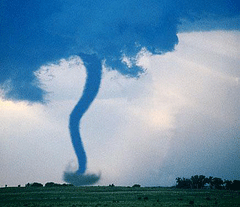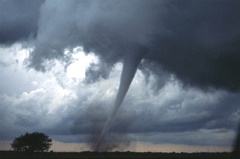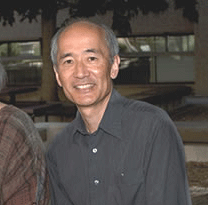Chasing Twisters
Air Date: Week of May 8, 2009
 |
For the next month, more than 100 researchers will caravan around the Midwest hoping to get in the path of a tornado. Roger Wakimoto is director of the Earth Observing Laboratory for the National Center for Atmospheric Research. He tells host Steve Curwood that despite past research, scientists still don't really know how tornadoes form.
Transcript
[TORNADO SOUNDS, MAN “IT’S A TWISTER, A TWISTER”]
CURWOOD: For the next four weeks or so, NOAA researchers are teaming up with some one hundred others, hoping to follow in Dorothy’s footsteps and get up close to a twister.
One of them is Roger Wakimoto, he’s director of the Earth Observing Laboratory at the National Center for Atmospheric Research or NCAR in Boulder, Colorado.
The goal: to find out exactly how violent rotating thunderstorms spawn tornadoes. The name of the project: VORTEX.

When tornadoes form in relatively dry air, they can appear hollow or translucent. (© UCAR; photo by Linda Lusk)
WAKIMOTO: It’s actually an acronym that I came up with. It stands for the Verification of the Origins of Rotation in Tornados Experiment. I like the acronym because when you hear the term vortex you sorta know what we’re doing. Once you understand what the meaning of the acronym is, I don’t think there’s any question what we’re trying to accomplish in the experiment.
CURWOOD: You’re study area is, what, some 900 miles between Texas to Minnesota. How can you possibly be at the right place at the right time to get to tornado data that you’re looking for?

Roger Wakimoto is the director of the National Center for Atmospheric Research Earth Observing Laboratory. (Courtesy of NCAR)
CURWOOD: The National Weather Service now has a warning time of about what thirteen minutes which is enough for people to get cover, but if you don’t hear that warning right away, it’s not all that much. Why is it that tornados are so hard to predict and monitor?
WAKIMOTO: There are a fair amount of large-scale storms that rotate in the Midwest. But only a very small fraction of them actually produce tornados. One of the big hypotheses that we’re looking at right now is exactly what triggers tornado genesis. You may be shocked by my statement saying that’s what we need to try to understand, but tornado genesis itself has been fairly elusive to us, even though we’ve been studying these phenomena for decades.

When tornadoes form in relatively dry air, they can appear hollow or translucent. (© UCAR; photo by Linda Lusk)
CURWOOD: So what do we know about tornado formation at this point? What are the right conditions for it?
WAKIMOTO: The right conditions – as I said earlier, you need a rotating thunderstorm. And actually the ingredients for rotating thunderstorms, we understand really well. It’s really just two things: you need the air to be very unstable, which means that it just wants to rise violently upward, and for most people what that means is very hot, humid conditions at the ground, and relatively cool, dry conditions aloft. And that is very unstable air. The other thing you need is strong winds, increasing with height. You get those two ingredients in the same area then you’re – you have a very high probability of getting a massively rotating thunderstorm. So that we understand. But it’s that next step – which rotating thunderstorm actually has the right ingredients to produce a tornado. That’s the missing link that we still are trying to solve.
CURWOOD: What do you think you might find about tornado genesis in this study?
WAKIMOTO: Well one of the hypothesis that we have about tornado genesis is that it’s very much related to downward air that’s coming from the storm. And in particular the downward air, or down drafts as we call them, might have a particular temperature structure that, for example, very cold down drafts might not be favorable for tornado genesis and very warm downdrafts might be more favorable.

An advancing tornado. (Courtesy of NASA)
CURWOOD: So if someone were to observe that the air temperature were rising if there were a bunch of rotating storms in the neighborhood, that might be a warning that a tornado could happen?
WAKIMOTO: It could be. If we can prove that that’s the case, then maybe we can develop some instrumentation that actually might measure that and be able to predict that a particular storm is going to form a tornado.
CURWOOD: We’ve seen some major shifts in weather patterns as the earth’s temperature has been slowly rising. Is there any connection between the perceived sense that there are more and more tornados now in the U.S. over the last few years and this question of global climatic change?
WAKIMOTO: That’s been something we’ve just started looking at. These early studies have suggested that we might have an increase in severe tornado activity and over a more extensive area in the United States than we’ve been typically accustom to.
CURWOOD: I gotta ask you this: you’re there at that gathering, that party and somebody says, “So, what do you do?” And you tell them “I chase tornados. I study tornados.” They gotta say, “that’s way cool.”
WAKIMOTO: They do. I mean that’s why I got into the business. I’ve been fascinated by it from a very young age.
CURWOOD: Roger Wakimoto is lab director of the Earth Observing Laboratory at the National Center for Atmospheric Research. Thank you.
WAKIMOTO: You’re welcome.
Links
Living on Earth wants to hear from you!
Living on Earth
62 Calef Highway, Suite 212
Lee, NH 03861
Telephone: 617-287-4121
E-mail: comments@loe.org
Newsletter [Click here]
Donate to Living on Earth!
Living on Earth is an independent media program and relies entirely on contributions from listeners and institutions supporting public service. Please donate now to preserve an independent environmental voice.
NewsletterLiving on Earth offers a weekly delivery of the show's rundown to your mailbox. Sign up for our newsletter today!
 Sailors For The Sea: Be the change you want to sea.
Sailors For The Sea: Be the change you want to sea.
 The Grantham Foundation for the Protection of the Environment: Committed to protecting and improving the health of the global environment.
The Grantham Foundation for the Protection of the Environment: Committed to protecting and improving the health of the global environment.
 Contribute to Living on Earth and receive, as our gift to you, an archival print of one of Mark Seth Lender's extraordinary wildlife photographs. Follow the link to see Mark's current collection of photographs.
Contribute to Living on Earth and receive, as our gift to you, an archival print of one of Mark Seth Lender's extraordinary wildlife photographs. Follow the link to see Mark's current collection of photographs.
 Buy a signed copy of Mark Seth Lender's book Smeagull the Seagull & support Living on Earth
Buy a signed copy of Mark Seth Lender's book Smeagull the Seagull & support Living on Earth

